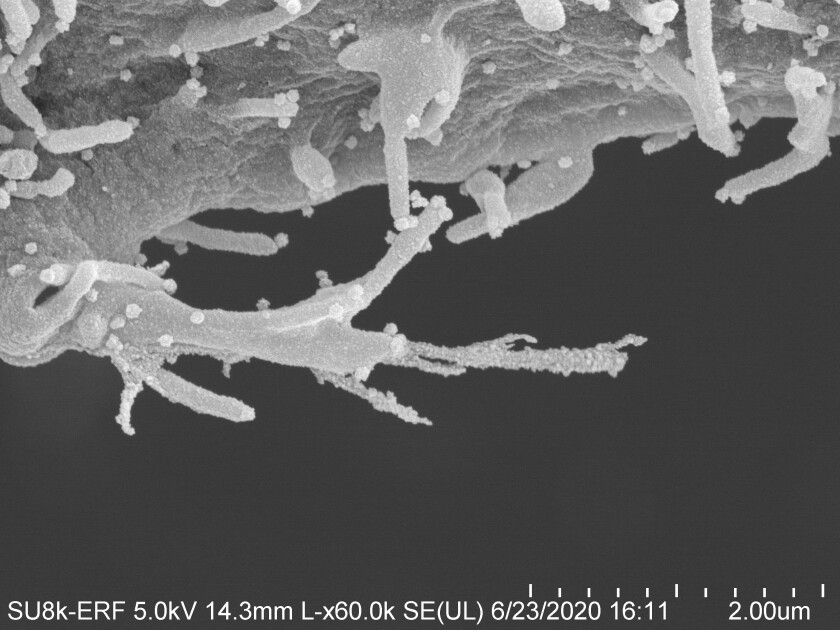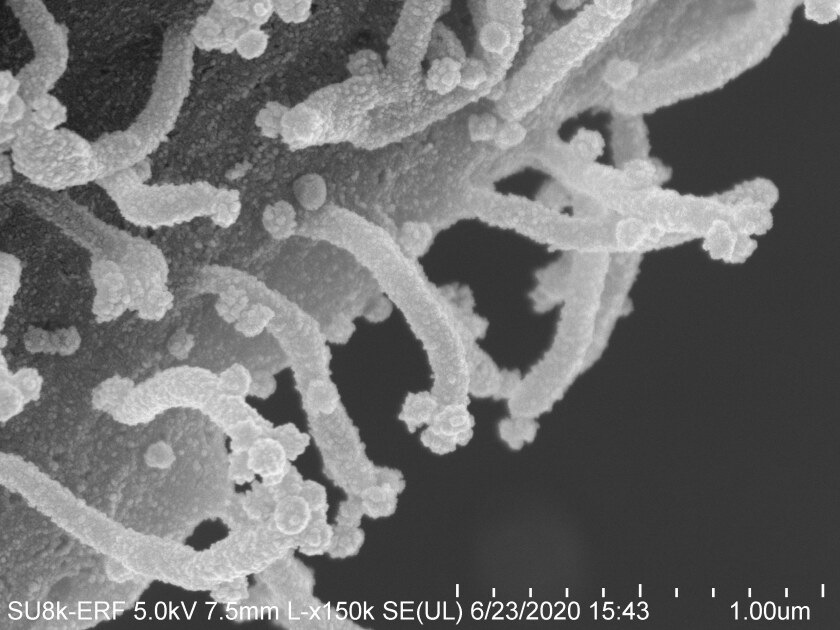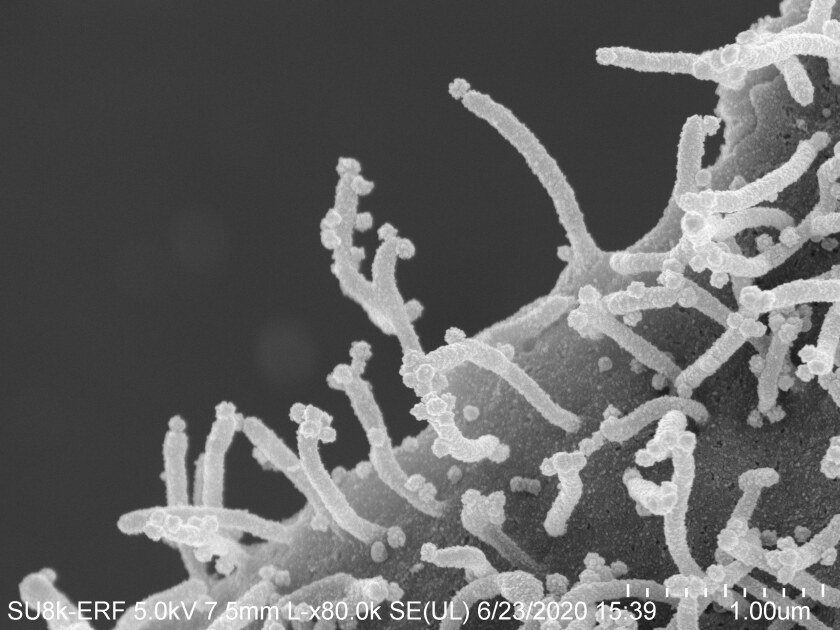- The coronavirus has evolved in multiple ways to infect more cells
- New research caught the virus with HIV like filopodia tentacles infecting healthy cells
- this has resulted in treatment proposals by scientists similar to those of cancer.
- Some cancer drugs like ralimetinib can disrupt the filopodia chemical signals and prevent the virus from infecting cells
- Scientists are not sure at what stage of infection this happens and whether it’s a secondary mode of infection
According to a Los Angeles Times report written by Melissa Healy, the new coronavirus’ reputation for messing with scientists’ assumptions has taken a creepy turn as scientists find out how deadly and far-reaching the consequences can be.
What is it?
Researchers exploring the interaction between the coronavirus and its hosts have discovered that when the SARS-CoV-2 virus infects a human cell, it sets off a ghoulish transformation. Obeying instructions from the virus, the newly infected cell sprouts multi-pronged tentacles studded with viral particles.
- These disfigured zombie cells appear to be using those streaming filaments, or filopodia, to reach still-healthy neighboring cells.
- The protuberances appear to bore into the cells’ bodies and inject their viral venom directly into those cells’ genetic command centers — thus creating another zombie.
The authors of the new study, an international team led by researchers at UC San Francisco, say
the coronavirus appears to be using these newly sprouted dendrites to boost its efficiency in capturing new cells and establishing infection in its human victims.
Their research was published Friday in the journal Cell.
Drugs That Could Prevent this Viral Takeover
The scientists also believe they have identified several drugs that could disrupt the viral takeover of cells and slow the process by which COVID-19 takes hold.
These compounds, many of which were designed as cancer treatments, seem likely to work because they block the chemical signals that activate filopodia production in the first place.
Among the seven drugs they identified as potentially useful against COVID-19 are
- Silmitasertib, a still-experimental drug in early clinical trials as a treatment for bile duct cancer and a form of childhood brain cancer;
- ralimetinib, a cancer drug developed by Eli Lilly; and
- gilteritinib (marketed as Xospata), a drug in use already to treat acute myeloid leukemia.
Proteomics Provides the Solution
The new research emerges from an ambitious effort to identify promising COVID-19 treatments using the science of “proteomics,” the interactions among proteins.
- Scientists set out to identify the chemical signals and cascading chain of events that take place when a virus meets and overtakes a host cell.
- Then, they look for drug compounds that could scramble those chemical signals and disrupt the process of infection.
- Until now, the process by which the coronavirus was thought to infect cells was pretty run-of-the-mill for a virus: It found receptors on the surface of the cells that line humans’ mouth, nose, respiratory tract, lungs and blood vessels.
- Like space invaders in a science fiction tale, the tiny virus was known to dock on the surface of the much larger cell
- A viral landing party came aboard and hijacked the cell’s usual function, making it a factory for its replication.

The discovery that the coronavirus initiates the sprouting of filopodia in infected cells suggests
that it has, at some point in its evolution, developed more than one way to ensure it gets passed quickly from cell to cell.
Typically, a rapid rise in infected cells will raise a victim’s viral load, make her feel sick and promote the transmission of the virus to other people. UC San Francisco’s Nevan Krogan, one of the paper’s senior authors, said there is much about the coronavirus that doesn’t match scientists’ expectations.
Virus Evolved in Multiple Ways
But the discovery of filopodia in coronavirus-infected cells suggests that this virus has developed more than one way to wheedle its way into cells and establish itself as a force to be reckoned with.
“It’s just so sinister that the virus uses other mechanisms to infect other cells before it kills the cell,” Krogan said. Other researchers include scientists from Mt. Sinai in New York, Rocky Mountain Labs in Montana (where these electron microscopy images were made), the Pasteur Institute in Paris and the University of Freiburg in Germany.

Cells sprouting filopodia not only look creepy. They keep some pretty nasty company as well.
Viruses That Uses this Mechanism
- Vaccinia, a member of the poxvirus family that causes smallpox, uses filopodia that sprout from infected cells to “surf” toward those cells and inject them with more viral particles, a 2008 study found.
- HIV and some influenza viruses have been known to use filopodia to enhance their ability to break and enter into cells.
Why do viruses do this?
Many viruses alter the exoskeleton of the cells they infect, and inducing filopodia is one way they do it, said Columbia University virologist Angela L. Rasmussen.
And while enhancing infection is one role they often play, there are many others.
But Krogan said even those viruses do not seem to set off the prolific growth of filaments that was seen by his colleagues on coronavirus-infected cells. The branching tentacles protruding from those cells were highly unusual

Columbia University microbiologist Stephen P. Goff urged caution in assuming that filopodia are necessarily behaving as a second mode of infecting cells with virus.
“It’s intriguing and a really cool observation,” Goff said. The study’s striking images show that the filopodia contain a lot of virus and that in the lab, inhibiting their growth seemed to reduce viral replication. This strongly suggests that filopodia are somehow amping up the virus’ ability to infect cells, he acknowledged.
“But we don’t yet know what stage [of infection] is affected” by the strange protrusions, he said.
“It will be great fun to find out.”
About the Author
Did you subscribe to our daily newsletter?
It’s Free! Click here to Subscribe!
Source: Los Angeles Times

















